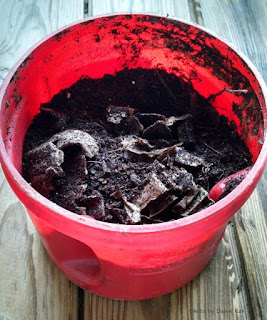
Composting is a large part of growing healthy gardens - even in the smallest gardens. That includes your balcony or patio garden. Composting is also important for the environment as you are reusing soil, leaves, food scraps, and other things that are sometimes overlooked and thrown out or left to blow away. If you create enough of your own soil through composting you will eliminate the need to purchase bags of soil from the store. Composting on your balcony can be as easy as putting old soil from your planters into a plastic container with the leaves from your spent plants and then forgetting about it. If you think I'm joking... read on.
Set it and Forget it Composting
That rich, wonderful soil in the intro photograph is mine. I literally placed some soil from a planter I was no longer using into a large coffee "can". I added egg shells, some leaves from dead plants (tomato plants if I remember correctly), ripped up cardboard containers from the plants I bought at the store, added some water, and placed it on the balcony. Initially, I turned it and shook it to mix the ingredients. But then after a short period of time, I didn't flip it, turn it, or do much else. Eventually, I brought it into a corner of the kitchen and completely forgot about it.
Today, I was looking for some soil so that I could plant a few garlic cloves as an experiment. I found this coffee can, that I had forgotten, full of this rich, wonderful soil. I also found an old planter that held the leaves I had collected in the autumn. Those leaves were so dried out that it was easy to crush them with my hands into fine bits. I stirred the coffee can soil and the dried leaf bits together and ended up with the prettiest potting soil I've ever seen.
I can only imagine the lovely soil I would have ended up with if I had put any effort into it.
The Best Containers for Balcony Composting
You can do as I did and use a large plastic coffee can. I chose the one I did because of the handy grips that are built-in. I did hold the lid on while I shook or turned it, as I did not want the lid flying off and decomposing bits flying all over. I had set aside a cat litter bucket with a lid and planned on using it for my composting experiment but had never gotten around to it. I wish I had used it. Can you imagine the amount of rich soil I'd have by now?
Many containers would be suitable for your apartment composting. There are small and attractive containers that can be kept on your kitchen counter for the collection of food scraps. You can use small buckets with lids, larger trash cans with lids, or plastic storage containers. If you have a large enough balcony, or have a patio instead, there are tumbler composters as small as 37 gallons that would make turning the compost a very easy task.
What to add to Your Apartment Compost Bin
An apartment balcony garden can be tricky. The plants die off and the landlords do not want the balcony used for "storage". Because of that, every autumn I empty some of the planters and tidy up a bit. There have been years that I've thrown the dead plants into the trash. But that seems oh so wasteful. Then in the spring the potting soil looks depleted and pitiful that I purchase new potting soil. Those things were what drove me to try the coffee can compost.
You can make your own amazing soil with any of the following ingredients:
- the soil from planters that no long have plants
- dead plants and leaves
- leaves you collect from the yard in the autumn
- kitchen scraps - fruit peels, vegetable trimmings, potato peels, and more
- egg shells
- shredded news paper
- cardboard (the chunks in the photo are the "cardboard" pieces discarded from the plants I had purchased at the nursery - regular cardboard decomposes more quickly)
- DO NOT ADD meats and/or dairy scraps to your compost
I feel that it is important to note that my first attempt with the coffee can compost container was not so successful. I had added many more egg shells and food scraps than dirt. I don't recall adding any plant matter. I had added quite a bit of water - enough that the consistency was along the lines of mud. I did not flip it, turn it, or stir it for a bit of time (a couple of weeks if I recall correctly). When I opened the lid, it smelled terrible! It is important to add your scraps to a sufficient amount of dirt. Composting does not require a large amount of water.
I want to add that I am clearly no composting expert. You should read other articles about the benefits of knowing the temperature of your compost, keeping scraps in the containers on your kitchen counter, and other educational articles that would address your needs.
My intent with this was to share my excitement about the rich and beautiful soil I created. And to help you know that it can be just as easy as set it and forget it to do. Your balcony garden plants will thank you.
Intro photo design created courtesy of FotoJet
*This article may contain affiliate links. If you shop via one of the affiliate links, I may earn a small commission - at no additional cost to you. I am very appreciative of every reader who visits my articles. Thank you.




















